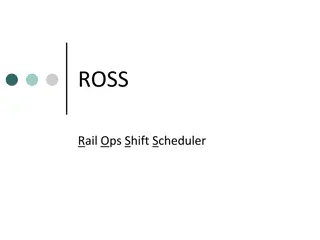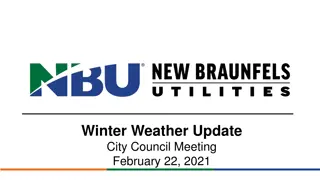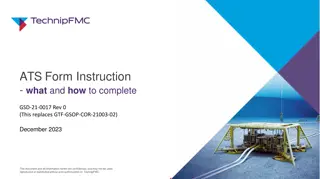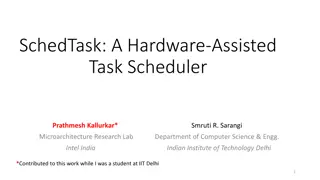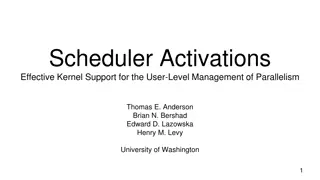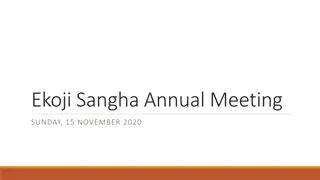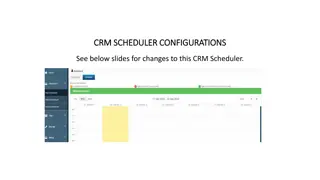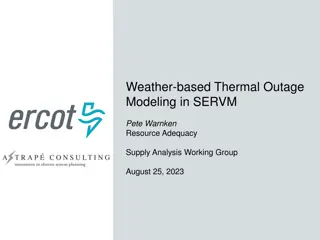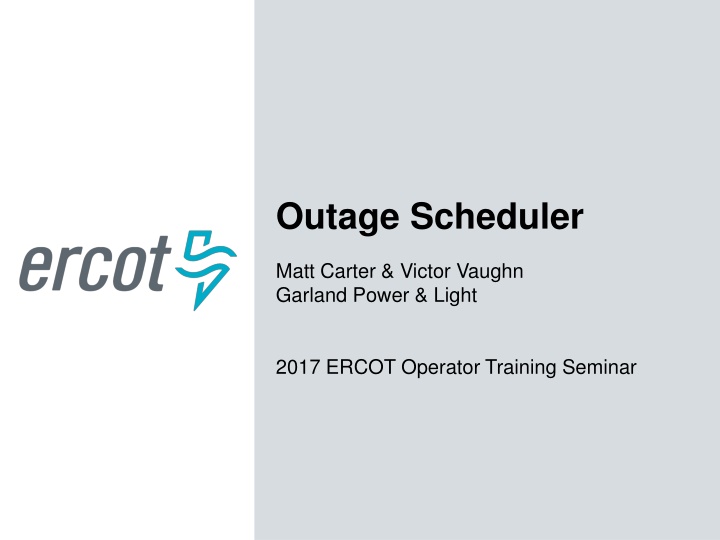
Understanding Outages and ERCOT Definitions
Learn about the definition of outages, important ERCOT definitions related to transmission facilities and resources, and how outages impact market operations. Explore examples and complete a worksheet to assess your understanding.
Uploaded on | 0 Views
Download Presentation

Please find below an Image/Link to download the presentation.
The content on the website is provided AS IS for your information and personal use only. It may not be sold, licensed, or shared on other websites without obtaining consent from the author. If you encounter any issues during the download, it is possible that the publisher has removed the file from their server.
You are allowed to download the files provided on this website for personal or commercial use, subject to the condition that they are used lawfully. All files are the property of their respective owners.
The content on the website is provided AS IS for your information and personal use only. It may not be sold, licensed, or shared on other websites without obtaining consent from the author.
E N D
Presentation Transcript
Outage Scheduler Matt Carter & Victor Vaughn Garland Power & Light 2017 ERCOT Operator Training Seminar
Learning Objectives Identify new features of the Outage Scheduler Application Describe how Outages impact Market Operations Demonstrate information required for submitting: o Transmission Facility Outages o Resource Outages 2 PUBLIC
Outage Scheduler Worksheet To meet assessment goals you are provided with an Outage Scheduler Worksheet. Follow along and fill in the blanks or answer the questions to get your credit for this session. Hint: Look for bolded text! Make sure your name is clearly printed! 3 PUBLIC
What is the definition of an Outage? The condition of a Transmission Facility or a portion of a Facility, Generation Resource or Load Resource that is: part of the ERCOT Transmission Grid defined in the Network Operations Model removed from its normal service excludes the operations of Transmission Facilities associated with the start-up and shutdown of Generation Resources 4 PUBLIC
Additional important ERCOT Definitions Transmission Facilities: Transmission Lines, Substations and associated Facilities operated at or above 60 kV. Transmission Elements - Part of a physical Transmission Facility that are: An Electrical Bus, Transmission Line, Transformer, Generator, Load, Breaker, Switch, Capacitor, Reactor, Phase Shifter, etc. Part of the ERCOT Transmission Grid Defined in the ERCOT Network Operations Model. 5 PUBLIC
Additional important ERCOT Definitions Resource The term is used to refer to both a Generation Resource and a Load Resource. Generation Resource A generator capable of providing energy or Ancillary Service to the ERCOT System and is registered with ERCOT as a Generation Resource. Load Resource A Load capable of providing Ancillary Service to the ERCOT System and/or energy in the form of Demand response and registered with ERCOT as a Load Resource. 6 PUBLIC
What then is the Outage Scheduler? The ERCOT Outage Scheduler is a web-based database and scheduling application which allows Market Participants to create, submit, view and edit outage requests for: Transmission Facilities Resources (both Generation & Load) The Outage Scheduler allows ERCOT to study the impact of multiple outage requests spanning varying time periods while meeting the outage coordination response times and goals described in the Protocols 8 PUBLIC
Lets Talk about the Different Types of Outages The Outage Request Menu s Look like this: QSE Create New Resource Outage Menu TSP Create New Transmission Outage Menu QSE Create New Transmission Outage Menu. QSEs have all of the same Transmission Outage categories and rules as TSPs no differences 9 PUBLIC
Outage Types Planned Transmission Outages Planned Transmission Outage - An Outage that is planned and scheduled in advance with ERCOT, other than a Maintenance Outage or Opportunity Outage. For Planned Transmission Outages, ERCOT will Approve or Reject the request in accordance with the following: Submittal (Prior to Planned Start) Greater than 90 days Between 46 to 90 days Between 9 to 45 days Between 4 to 8 days 3 days ERCOT Approval 75 days 30 days 4 days 3 days 2 days 10 PUBLIC
Outage Types Planned Non-Reliability Resource Outages Planned Resource Outage Any major Resource Facility Outage (other than a defined Maintenance Outage) that is Planned and Scheduled in Advance For Planned Resource Outages, ERCOT will approve or reject the request in accordance with the following: Submittal ERCOT Approval (Prior to Planned Start) Greater than 45 days Automatically Accepted. Will notify Submitter Within 5 Business Days of any Conflicts Automatically Accepted by end of 5th Business Day if not Approved or Rejected By 1800 3 days Prior By 1800 2 days Prior Between 9 to 45 days Between 4 to 8 days 3 days 11 PUBLIC
Outage Types Transmission & Resource Maintenance Outages An outage initiated manually to remove equipment from service to perform work on that is required to prevent a potential Forced Outage and cannot wait until the next Planned Outage. There are three levels of Maintenance Outages. Level 1: equipment must be removed from service within 24 hours Level 2: equipment must be removed from service within 7 days Level 3: equipment must be removed from service within 30 days Note: For all 3 Levels QSEs must Update their COP within 1 hour and notify ERCOT verbally. 12 PUBLIC
Outage Types Transmission & Resource Forced Transmission Forced Outage - Initiated by protective relay (or manually, in response to an observation by personnel that the condition of equipment could lead to potential event) that poses a threat to people, equipment, or public safety. Resource Forced Outage - requires immediate removal, either through controlled or uncontrolled actions, of all or a portion of the capacity of the Resource from service through automated or manual means. TSPs & QSEs must: Verbally communicate the outage to ERCOT immediately. Submit into the Outage Scheduler as soon as Practicable. QSEs must update their COP 13 PUBLIC
Outage Types Opportunity Outage Resource Opportunity Outage: May be accepted by ERCOT when a specific Resource experiences a Forced Outage and Resource had been previously Approved or Accepted for a Planned Outage during the next eight days Transmission Opportunity Outage May be approved by ERCOT when a specified Resource will be outaged and TSP has an outage Received at ERCOT for Transmission Elements associated with the specified Resource 14 PUBLIC
Outage Types Remedial Switching Action Remedial Switching Actions: Considered to be a type of Forced Outage Submitted for real-time switching devices that will be opened to relieve or prevent an overload condition Must start within three days Must have a maximum restoration time of four hours Cannot exceed 72 hours in duration. 15 PUBLIC
Outage Types Simple Outages Simple Transmission Outage A Planned Outage or Maintenance Outage such that when the Transmission Element is removed from its normal service, the Outage does not cause: A topology change in the LMP calculation and Cannot cause any LMPs to change with or without the Transmission Element that is suffering the Outage. Maximum Restoration Time cannot exceed 1 Hour. 16 PUBLIC
What Are the Two Types of Outage Extensions? Unavoidable Extensions: Apply to Planned, Maintenance & Simple Outages Forced Extensions: Apply to Forced Outages Only For both Types of Extensions: New Planned End may be submitted multiple times for up to two hours after the Planned End New Forced Outage required after Planned End time plus two hours Supporting Information is Required in the Notes area. 17 PUBLIC
So, What Processes use Outage Scheduler Data? Forced Outage Detection Congestion Revenue Rights Day-Ahead Energy Awards Outage Evaluation Security Constrained Economic Dispatch Ancillary Service Deployments Security Analysis Settlements Reliability Unit Commitment Outage Reports Real-Time processes Do Not use the Outage Scheduler Why? Because of Forced Outages and other unexpected events. 18 PUBLIC
Outage Type Review As we can see the type and the date when the Outage was submitted does affect several of the models and applications which ERCOT uses to conduct business. Question time What are some of the outages that can affect CRRs? (Planned, Forced, Maintenance, Remedial Switching & Simple) (What about an extension?) What types of outages affect Real-Time? (Unavoidable & Forced Extensions, Maintenance Level 1) What about the Day-Ahead? (Forced, Maintenance, Remedial, Simple) 19 PUBLIC
Outage Scheduler Enhancements Project Fall 2016 Spring 2017
Enhancement Added Capability for QSEs to submit Transmission Facility Outages. Created the ability for QSEs to submit and be responsible for Outage Coordination of the Transmission Facilities associated with the Resources which they operate. Resource Entity-Owned Transmission Facilities shall meet the same timeline for submittal and outage reporting requirements as TSP Transmission Facilities for: Planned Outages Maintenance Levels 1, 2 & 3 Simple Outages Forced Outages Remedial Switching Actions Opportunity Outages 21 PUBLIC
Enhancement Added Capability for QSEs to submit Transmission Facility Outages. (Con t) Due to the different ERCOT Approval, Acceptance and Rejections timelines between Resource and Transmission Facility requests, QSEs shall not be allowed to submit Group Outages containing Resource and Transmission Facilities. 22 PUBLIC
Enhancement New Planned End New Planned End: Appears after Actual Start has been entered. May be Revised multiple times for up to Two Hours past the Planned End. After Planned End plus Two Hours, if the Outage needs to continue, a Forced Outage must be submitted 23 PUBLIC
Enhancement Outage History Records Outage History will report the date and time, and Requestor Name of every action related to when an outage is: Created Submitted Approved/Accepted or Rejected Extended Modified Cancelled or Withdrawn Completed (Actual End Submitted) All Requestor Notes and related-ERCOT Reviewer Notes will be included. History 24 PUBLIC
Enhancement Outage History Records (Cont) Outage History Retrieval Rules Access via Outage Scheduler User Interface Only TSPs may access all Outage History records QSEs may access records for the Transmission and Resource facilities they operate. Use Custom Filter to locate the desired Detailed Outage Request. Files are downloaded in .xlxs Format History 25 PUBLIC
Enhancement Multiple Overlapping Derates QSEs are now able to submit multiple, overlapping Resource Derates in multiple Outage Types (Planned, Forced and/or Maintenance) For Resource Derates, all ERCOT processes shall use: The Lowest HSL submitted, and The LSL associated with the Lowest HSL. QSEs are solely responsible for the submission and accuracy of all Derate Outages. 26 PUBLIC
Enhancement - Nature of Work, Reasons for Cancellation and Grouped Outages The following were added to the Nature of Work types and Reasons for Cancellation as shown: Nature of Work Breaker/Repair Replace Telcom Work Third Party Request Cancellations Weather Conditions Materials Unavailable Labor/Crew Unavailable Emergency Operations Maximum number of Transmission Elements in a Grouped Outage is now 60 Pieces of Equipment 27 PUBLIC
Summary Screen Enhancements TSPs have the ability to see: All Transmission Outages All Resource Outages QSEs may see: Only the Resource and Transmission Outages which they submitted. Outage Summary is the only place a QSE can view them together. Remembers Desired settings between Sessions View feature allows 25, 50, 100 or 200 Rows per page Removes Completed and Cancelled Outages from the Summary View. Select to Expand and Collapse Group Outages Width of Outage Summary Screen reformats to fit Tablet, Laptop and large-screen monitors. 28 28 PUBLIC
Enhancement Custom Filter Enhancements include: Searches may be submitted on Single or Multiple Criteria. Display Transmission and Resource Outages together. Return up to 7000 results Added ability to Search by Station or Nature of Work only. Typing data into a search field narrows the selection choices. TSP Custom Filter QSE Custom Filter 29 PUBLIC
Enhancement Custom Filter At least one of the following selections is required: Outage ID Group ID Requesting Company Operating Company Station If Requesting Company or Operating Company is the only search criteria selected, an Effective From/To date range is Required. TSP Custom Filter QSE Custom Filter 30 PUBLIC
High Impact Outage Project Fall 2017 Spring 2018
High Impact Outage-related Definitions Transmission Element (Previously Shown) A physical Transmission Facility that is either an Electrical Bus, line, transformer, generator, Load, breaker, switch, capacitor, reactor, phase shifter, or other similar device that is part of the ERCOT Transmission Grid and defined in the ERCOT Network Operations Model. High Impact Transmission Element (HITE) A Transmission Element that may, in certain conditions, result in high congestion risk when taken out-of-service High Impact Outage (HIO) A Planned Outage that interrupts flow on a High Impact Transmission Element (HITE). 32 PUBLIC
Which leads us to a new Outage Type! Rescheduled High Impact Outage An Approved Planned Transmission Outage with: One or more High Impact Transmission Elements (HITEs) Submitted greater than 90-days prior to the Planned Start And, subject to withdrawal of approval by ERCOT Only ERCOT shall be able to convert a High Impact Outage into a Rescheduled Outage after discussion with the Requestor. Rescheduled Outage training will be conducted prior to implementation Fall 2017/Spring 2018 33 PUBLIC
Outage Scheduler Data Requirements 2017 ERCOT Operator Training Seminar
Outage Scheduler - Data Requirements General Information is required for all Transmission & Resource Requests General Information is pre-populated from Digital Certificate Primary and Secondary phone numbers may be changed by submitting a Notice of Change of Information form Remembers the Name and Phone Number entered from previous session. These fields are required data. Enter the Number you would want an ERCOT Outage Coordinator or System Operator to contact you at! Requestor Name will be captured in External Web Services and Outage History Reports 35 PUBLIC
Outage Scheduler - Data Requirements Transmission Outage Data Fields All Four Date/Time Fields Outage Analysis uses Planned Start & Planned End.. Earliest Start & Latest End used for alternate evaluation only! Emergency Restoration - Cannot be longer than the Outage Duration Project Name Not a Required Field Used by Requestor to reference Projects 36 PUBLIC
Outage Scheduler - Data Requirements Resource Outage Data Fields Outage Analysis uses Planned Start & Planned End.. Earliest Start & Earliest End used for alternate evaluation only! 37 PUBLIC
Outage Scheduler - Data Requirements Transmission & Resource Nature of Work Pull-Down Required Field Pre-Populated with Generic Transmission or Resource types of work RESOURCE OUTAGES Black Start Test Boroscope Combustion Inspection and Repair Cooling Water Problems/Repairs Exhaust Problems/Repairs Feedwater Problems/Repairs Fuel Limitation/Lack of Fuel Availability Fuel Problems/Repairs Gas Company Pipeline Work Inlet Air Problems/Repairs Lack of Steam Load Availability Mothballed Overhaul Steam Turbine Limited/Unavailable Tube Leak Turbine/Generator Vibration/Repair New Equipment Energization Retirement of Old Equipment Other Unknown TRANSMISSION OUTAGES Associated Equipment Outage Breaker Maintenance Breaker Repair/Replace Line Maintenance Line Rebuild/Upgrade Relay Work Repair Hot Spot Repair/Replace Damaged Equipment Replace Equipment Switch Maintenance Switch Repair/Replace Telcom Work Third Party Request Transformer Maintenance Transformer Repair/Replace Transformer Testing New Equipment Energization Retirement of Old Equipment Other Unknown Nature of Work 38 PUBLIC
Outage Scheduler - Data Requirements Transmission & Resource - Selecting Equipment Operating Company defaults to Digital Certificate Top down Hierarchy Transmission Equipment Select Station first to pre-populate lower fields Definition Select additional equipment to create Group Outages CB LN DSC XF SC LD SVC (Capacitors & Reactors) Resource Equipment UN LR Model Circuit Breaker Line Disconnect Transformer Series Compensator Load Higher selections clear lower fields Static Var Compensation Devices Equipment Name In Service Date equipment added to the Network Model Out Service Date Equipment removed from the Network Definition Unit Load Resource PUBLIC
Outage Scheduler - Data Requirements Transmission & Resource Actual Start Field Actual Start Entry field not available until the Outage has been Approved or Accepted May be edited for two hours. Actual End and New Planned End entry fields will not appear until after Actual Start has been submitted PUBLIC
Outage Scheduler - Data Requirements Transmission & Resource Actual End Field Actual End: Appears after Actual Start Submitted. Can be edited For two hours. New Planned End: Appears after Actual Start has been entered. May be Revised multiple times for up to Two Hours past the Planned End. After Planned End plus Two Hours, if the Outage is to continue, a new Forced Outage must be submitted PUBLIC
Outage Scheduler - Data Requirements Transmission & Resource Notes Requestor Notes Must enter reason when using Other or Unknown for Nature of Work Requestor should enter any supplemental information which will aid ERCOT during outage analysis (the more info the better!) RAP or RAS Notes (Note: SPS changing to Remedial Action Scheme ) Required if disabling or impacting a Remedial Action Plan or Special Protection System Supporting Information Explanation of how an Outage qualifies as a Forced Outage Required before the following can be designated as Complete Forced Outages Forced Extensions Unavoidable Extensions Remedial Switching Actions PUBLIC
There is a Planned Transmission Outage on Line 04. During switching, line switch C020 binds up halfway open. 1) What s the first thing you do? 2) How is this entered in the Outage Scheduler? 3) The Field Crew calls 20 minutes after the Planned End time and tells the Requestor that it will take another two hours for the repair. What does the Requestor do? Scenario 1 L08 C040 C1 C2 C3 C4 C5 C6 S010 C030 C020 L10 L11 Line 04 MT03 CD03 C 300 CT03 S040 XT02 B1 B2 B3 CD02 MT02 C 200 CT02 S ST01 100 B4 B5 B6 SD01 MT01 XT01 S010 S020 S030 L02 L03 L01 43 PUBLIC
All Units are On-Line. An insulator on switch SD01 fails, causing a fault in unit ST01 to trip. During the initial visual inspection, it is noted that there is a small amount of damage to switch CD02. The Resource Entity decides to Derate CT02 by 20 MW for 3 days until ST01 repairs can be completed. 1) What outages need to be submitted for Unit ST01 and who submits them? 2) What needs to be done for CT02? Scenario 2 L08 C040 C1 C2 C3 C4 C5 C6 S010 C030 C020 L10 L11 Line 04 MT03 CD03 C 300 CT03 S040 XT02 B1 B2 B3 CD02 MT02 C 200 CT02 S ST01 100 B4 B5 B6 SD01 MT01 XT01 S010 S020 S030 L02 L03 L01 44 PUBLIC
Scenario 3 Your company is adding new equipment in a substation expansion. All the distribution load will be picked up in the field. The Transmission contractor is going to install a bypass around the station to keep the transmission interruptions to a minimum while building the substation. The email from ERCOT below shows your approved NOMCR. 45 PUBLIC
Scenario 3 Equipment (1101_CS) out of service date 1/11/17 12:00 AM Equipment (DSW_8014) out of service date 1/11/17 12:00 AM Equipment (DSW_8027) out of service date 1/11/17 12:00 AM Equipment (SWIND_1) out of service date 1/11/17 12:00 AM You go into the outage scheduler to extend the outage as requested by the Transmission Contractor. When you try to submit the request, you get the warnings shown in Red. 1) What does this mean? 2) How would you enter the extension? 46 PUBLIC






